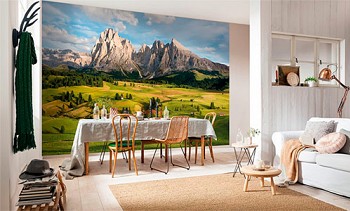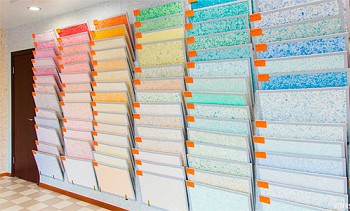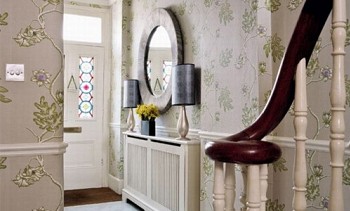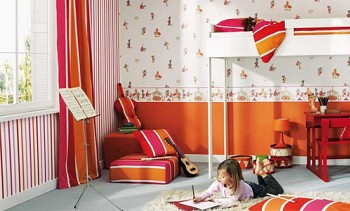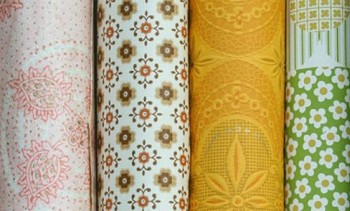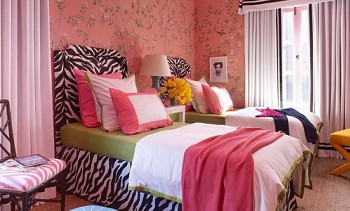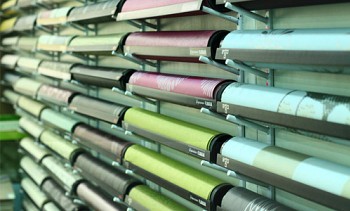Today you can buy wallpapers for every taste and budget - both for a luxurious country mansion and for a modest Khrushchev. However, a wide selection does not mean facilitating the purchase process. The person standing in the store in front of this abundance of materials for wall decoration, immediately a lot of questions arise. How, with the exception of colors, do some wallpapers differ from others? Which wallpaper is better - vinyl, non-woven or paper? How not to make a mistake with the choice? The answer is obvious - you need to get at least a general idea of modern wallpaper, and only then, armed with knowledge, go to the store.
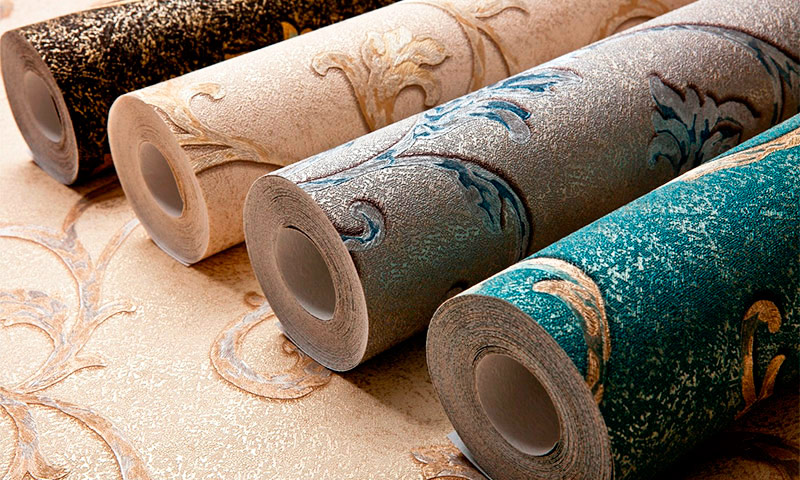
Content:
- What are vinyl, non-woven and paper wallpapers and their varieties
- Green wallpaper
- Wallpaper vapor permeability
- Wear resistance, light fastness and service life of wall-paper
- Contamination and cleaning ability
- Moisture resistance
- The ability to hide small irregularities
- The complexity of the process of gluing walls
- Which wallpaper has a more diverse design
- Possibility of painting
- The final comparison of vinyl, non-woven and paper wallpapers
- In which rooms is it better to use vinyl, non-woven and paper wallpapers
What are vinyl, non-woven and paper wallpapers and their varieties
Paper wallpaper you can safely call it a classic wall coverings. There is an opinion that they are outdated and are no longer interesting to anyone. However, statistics claim the opposite: paper wallpapers are still in demand. And this is not surprising, because the word "classic" is primarily associated with quality that has been tested for centuries.
Cellulose is the basis of paper wallpaper, and this determines all their advantages and disadvantages: low moisture resistance and insufficient strength, but at the same time high air and vapor permeability and a relatively low price. There are two varieties of paper wallpaper - single-layer (or simplex) and two-layer (or duplex). The second is stronger and more durable, and gluing them is much easier. Washable paper wallpapers are usually made on the basis of a simplex, which is covered with a layer of decorative varnish.

Non-woven wallpaper - The closest relative and worthy competitor to paper. Non-woven fabric is a non-woven material made from compressed natural (cellulose) and synthetic (most often polyester) fibers. It has all the advantages of paper (high environmental friendliness, air and vapor permeability) and at the same time it is largely devoid of its drawbacks (in particular, non-woven wallpaper does not deform when wet, more durable and wear-resistant than paper). More often, non-woven wallpaper is used as a relief base for painting, but if desired, you can choose a coating with a color background and pattern already applied.

Vinyl wallpapers - A type of wallpaper, the protective and decorative coating of which is a layer of polyvinyl chloride (in everyday life often referred to simply as vinyl). As a basis for a polymer film, either paper or non-woven can be used. The top layer of this two-layer cake determines the performance of the wallpaper, the bottom holds the canvas on the wall. Polyvinyl chloride is not afraid of water, or organic solvents, or aggressive chemical compounds. It is resistant to mechanical stress, strong and durable.
There are several varieties of vinyl wallpaper that differ in the method of applying the PVC layer and, as a result of this, the properties:
1. Wallpaper made of foamed vinyl is obtained by heat treatment of polyvinyl chloride already applied to the substrate, which foams as a result, and the surface of the wallpaper acquires a pronounced relief.Distinctive features of such wallpapers, in addition to noticeable roughness, are soft texture, large thickness, which allows you to hide the unevenness of the wall, and a relatively low density.

2. Flat vinyl (or hot stamping vinyl) wallpapers are also produced at high temperatures. A layer of polyvinyl chloride mass is uniformly applied to the base — paper or non-woven — then the pattern is “rolled”, and after that the hot embossing step follows, as a result of which a unique wallpaper is born. These wallpapers are the most popular because they are distinguished by very high strength and moisture resistance, a wealth of available colors and patterns. The so-called silk-screen printing (wallpaper imitating silk fabric) belongs to the same type.

Green wallpaper
We all want to feel safe in our own home. Among other things, this means that the building and finishing materials used during the repair should not be fraught with a hidden threat to the health of you and your household. What in this regard should be expected from this or that type of wallpaper? Which wallpaper is more environmentally friendly - vinyl, non-woven or paper?
Paper wallpapers, of course, are impeccable from an environmental point of view, and this is one of their main advantages. The probability of release of toxic or potentially allergenic substances from non-woven, which is based on the fibers of the same cellulose, is also reduced to almost zero.
But vinyl wallpapers may not be as harmless as their competitors. If low-quality polyvinyl chloride was used in their production, it is subsequently possible to isolate a number of substances harmful to health, primarily the original vinyl chloride. Of course, the amount of unreacted monomer and other impurities in the polymer film is negligible, but you should not forget that the area of the walls covered with wallpaper in the apartment is quite large.
At the first time after the wallpaper sticker, when the concentration of these substances in the room air is maximum, their presence can be determined even by smell. Branded materials for organoleptic indicators differ for the better, but they also cost significantly more. But even if you bought the most expensive vinyl wallpapers that, according to the certificate, meet all sanitary and hygienic requirements, it is better to refrain from using them in long-term rooms, for example, in bedrooms or children's rooms.
The danger potential of vinyl wallpaper is higher than that of paper and non-woven, which are materials of high environmental quality.
Wallpaper vapor permeability
Humidity inside and outside is usually different. If there is a difference in the partial pressure of water vapor from different sides of the partition, it will move in the direction of reduced pressure, i.e. low humidity, and a concrete or brick wall will not become for him an insurmountable barrier.
Different materials have different vapor permeability. However, at the moment we are only interested in wallpaper. What about their ability to pass water vapor? Paper and non-woven, due to its fibrous structure, have excellent air and vapor permeability. But the polyvinyl chloride film almost tightly seals the pores in the substrate, preventing the penetration of water molecules into the wall. Foamed vinyl wallpapers have a slightly better vapor permeability, but they can not be compared with paper and non-woven.

What does this mean in practice? When comparing the vapor permeability of various materials used for gluing walls, many people begin to talk about changing the microclimate in the room. However, it should be said that the amount of steam passing through the wall, no matter what material it is made of or whatever wallpaper it is pasted over, is incomparable with the transported air during its free exchange.In other words, the indoor microclimate is determined not so much by the vapor permeability of the wall materials as by the quality of ventilation. If there is no air circulation, then no “breathing” wallpaper will help.
There is, however, another aspect of the issue under consideration. In some cases, the walls of residential buildings are quite wet, and there may be several reasons for this. On the first floors it can be a neighborhood with a damp basement, on the last floors - a neighborhood with a poorly waterproofed roof. Walls can also be dampened due to poor external thermal insulation, which leads to condensation of water vapor directly inside the wall.
If the wet wall is covered with a material with good vapor permeability (in our case, paper or non-woven wallpaper), it can theoretically be dried by creating conditions suitable for this indoors. If the coating is vapor tight (vinyl wallpaper), it is almost impossible to do. As a result, an ideal environment for the growth of mold or fungus will be created under such wallpaper.
The vapor permeability of vinyl wallpaper is significantly lower than paper and non-woven.
Wear resistance, light fastness and service life of wall-paper
No wonder repair is compared with several fires or floods. When it finally comes to an end (or stops?), We joyfully sigh and swear that we will never again for any reason of our own free will ... That is why we all really want the fruits of our labors, including glued wallpaper served us as long as possible. What types of wallpapers have the best wear resistance? Which over the years will not lose the brightness of colors and their original attractiveness?
Paper wallpapers, especially single-layer ones, have recently been in less and less demand, and one of the reasons for this is their insufficient resistance to abrasion, humidity, and exposure to sunlight. Some manufacturers cover their wallpaper with special compositions designed to increase their moisture and light resistance. However, even after such protection, they will not last you too long.
Non-woven wallpaper is also not much more resistant than paper to moisture and mechanical stress - in “harsh” operating conditions, their top layer quickly becomes unusable. It is usually not necessary to speak of photosensitivity of non-woven fabric, since they, as a rule, initially do not differ in the brightness of colors.
But vinyl wallpapers are not afraid of either the sun, or water, or physical impact. The polymer coating (with the exception of foamed PVC) has increased strength and resistance to mechanical damage. The film will not be erased even in places of constant contact with furniture or outerwear. Due to the excellent mechanical properties of polyvinyl chloride, wallpaper from it is often pasted in places with the highest traffic, for example, in hallways. In addition, they are easy to wash, not afraid of aggressive detergents and do not fade in the sun.
As a quantitative assessment of the "vitality" of various types of wallpaper can be their service life, as claimed by the manufacturers. In the case of paper wallpaper, manufacturers guarantee their perfect operation for 4-5 years. In the case of non-woven wallpaper, this figure increases to 8-10 years. In both cases, the warranty requires compliance with the prescribed operating conditions, namely protection against moisture and mechanical damage. Vinyl wallpapers have a slightly longer service life - 10-12 years (for a number of wallpapers, most often elite, some manufacturers declare a 20 year warranty), but at the same time, operational restrictions are much milder and fewer.
Vinyl wallpapers will last you longer without losing their original appeal.
Contamination and cleaning ability
One awkward movement and ... on a still brand new wallpaper, the spot “flaunts”. The likelihood of such an incident is especially high in the kitchen or in the hallway.And now what i can do? “Admire” the result of their negligence until the next repair? If the wall is covered with paper or non-woven wallpaper, then, alas, yes. Their porous structure contributes to the rapid and durable absorption of any dirt. And since paper and non-woven material possess not only high porosity, but also relatively low moisture resistance, it is impossible to wash them, with rare exceptions.
But vinyl wallpapers come out of such situations as winners. The dirt in their smooth polymer coating is practically not absorbed. In addition, vinyl is a moisture-resistant material, which means that it can be washed if necessary, not only with water, but also with detergents that do not contain chlorine and abrasive particles.
Vinyl wallpapers are easy to clean: they are slightly dirty and easy to clean. Unfortunately, this cannot be said about paper and non-woven wallpaper.
Moisture resistance
The hygroscopicity and moisture resistance of the wallpaper not only regulates the restrictions on their wet cleaning, but also determines the possibility of using this material in a particular room. The increased moisture sensitivity of paper and non-woven wallpaper limits their use to rooms with dry air, such as bedrooms or living rooms.
For some of them, processed with a special composition, these restrictions are not so severe - they can be successfully used, for example, in the kitchen. But even such “washable” paper doesn’t have a place near shower stall or sinks - it will quickly become worthless. Vinyl wallpapers, being non-hygroscopic and waterproof, are not afraid of dampness either in the form of steam or in the form of water splashes, which is why it is recommended to use them for decorating bathrooms, bathrooms, and kitchens.
Only vinyl wallpapers are truly moisture resistant, so they can be used for finishing damp rooms and, if necessary, washed with water.
The ability to hide small irregularities
The walls in our homes (even in new buildings, to say nothing of the old housing stock) rarely have flaws. Ideally, before stickering the wallpaper, they should be aligned, smoothing out all the bulges and depressions, and repairing all the cracks and potholes. But what if your budget is limited or the time allotted for repairs is rapidly coming to an end? What wallpaper will help to hide the fact that you missed this preparatory stage of work?
The ideal option in this case would be thick vinyl wallpaper. It is not recommended to use vinyl with a smooth glossy surface on uneven walls, as it will only increase the visibility of defects, display them. But foamed vinyl will do like nothing better: it has good embossment and dullness, which allows you to successfully “hide” problem areas.
You can use a cheaper option - two-ply paper wallpaper. They are denser than single-layer and often also have convex embossing, which means that our goal will be achieved to one degree or another.
But non-woven wallpaper on poor quality walls is not recommended for gluing. Often they turn out to be too transparent, and spots become visible through them - unevenness of the color background of the rough wall. But, in principle, such wallpapers are intended for painting, and a layer of water emulsion will help to hide the defect, especially if you choose the right color.
In general, in this situation, you need to follow a few simple rules that can easily help hide minor wall defects:
- The thicker the structure and the deeper the texture of the wallpaper, the better.
- The surface of the wallpaper should be matte, not glossy.
- Refuse from the use of plain wallpaper, give preference to a bright active pattern, preferably without strict geometry.
The palm on the ability to hide small irregularities and wall defects belongs to the foam vinyl wallpaper. Worse, but still coping with this task and duplex paper wallpaper, and non-woven wallpaper for painting.
The complexity of the process of gluing walls
Those who carry out repairs on their own, without resorting to the services of professional finishers, are interested not only in the consumer characteristics of different types of wallpaper, but also how easy it is to paste them on the walls.
Single-layer paper wallpaper gluing is not very simple. Thin paper, soaked after applying glue, strives to tear and is difficult to smooth on the wall, forming bubbles and folds. After drying, it shrinks, often exposing the joints between the canvases. Two-layer under the action of glue practically do not get wet, therefore they do not deform, and it is easier to fix them on the surface.
For those who had experience gluing walls with paper wallpaper, work with non-woven fabrics will seem much easier. The glue is applied only to the wall, after which an absolutely dry cloth is simply applied to the surface and smoothed out - it will not be difficult to join two strips. The material hardly stretches and does not deform. In addition, it is stronger than paper, which means that you will not be afraid to tear it by pulling the canvas too much at some point.

There is another feature of non-woven wallpaper, which some attribute to advantages, others to disadvantages: their width is twice the standard width of paper rolls (106 cm instead of 53 cm). A large width of the canvas means fewer joints, and this, firstly, improves the aesthetic appearance of the glued wall, and secondly, speeds up the process, especially when you have to join the pattern. But gluing wide canvases alone is more difficult than narrow ones - it is better at this stage of finishing and repair work to find a partner.
Vinyl wallpaper when comparing the complexity of the process of gluing walls occupies an intermediate position between paper and non-woven. Depending on the base, the adhesive is applied either only to the wall, which greatly facilitates the work, or to the canvas. The width of the rolls of vinyl wallpaper (with all the pros and cons resulting from this) varies depending on the substrate: on a non-woven base - wide format, on paper - narrow.
The main disadvantage of vinyl is the increased density compared to paper and non-woven, and therefore the mass. Hence the stricter requirements for the adhesive composition - it must be viscous enough to hold a heavy canvas on the wall.
Pasting walls with non-woven wallpaper is easier than vinyl. Paper ones are outsiders in this rating.
Which wallpaper has a more diverse design
Today, people are less and less choosing low-key wallpapers, realizing that this is not just a background for furniture, but one of the style-forming components of the interior.
Paper wallpapers are highly decorative. The most varied patterns and ornaments are applied to them, and all kinds of embossing are used to give volume. The relief pattern is created using paste-like paints, smooth - through liquid compositions. As a result of using different technologies, the coating can look like velor, silk or decorative plaster.

Vinyl coating also creates room for creativity. It allows you to simulate a variety of textures (including fabric, leather, suede, silk) and reproduce any colors and patterns. The palette of available colors is striking in its richness: today more than a hundred plain colors are produced, and it is almost impossible to count various variations with drawings, ornaments and patterns.

Against the background of paper and vinyl wallpapers, non-woven look rather modest. With their help, it is difficult to achieve reliable simulation of various materials. But the picture on the non-woven fabric turns out to be deeper: the manufacturers succeed in giving the image volume by mixing the fibers pre-dyed in different colors. Varying the density of the paint allows you to achieve a wide variety of visual effects.

Vinyl wallpapers allow you to put into practice the most diverse ideas of interior designers.Paper only lags behind them in their decorative properties.
Possibility of painting
Even two or three decades ago, it never occurred to any of us that wallpaper can be painted. Meanwhile, this simple solution allows you to achieve two goals at once. Firstly, no matter how diverse the assortment of wallpapers available on the market, there are always people who want something else, something that is not on the store counter, and painting helps put their design plan into practice. Secondly, over time, even the most beautiful wallpapers get bored, there is a desire to refresh the interior a little, and here again a roller and a bucket of water-based paint come to the rescue, which provide an invaluable opportunity to change the color of walls with minimal effort and money.
The most suitable base for painting is non-woven. It is quite dense and has a pronounced relief that facilitates the retention of a thick layer of water emulsion. Often such non-woven wallpaper is released unpainted, since it is initially assumed that the next stage after gluing the walls will be painting. Less common are colored, usually warm pastel shades.

Painting vinyl wallpapers is also possible, but the requirement of a relief rough surface narrows the range of materials to wallpaper made of foamed polyvinyl chloride. There is another limitation - the original color should be light and solid. Vivid wallpaper is not always successful in repainting due to the high intensity of the original color.
Suitable as a basis for painting and paper wallpaper with embossed texture. They have a greater than usual thickness and density, so that when applying paint they practically do not deform. Such wallpaper is impregnated with a special water-repellent composition that allows the material to maintain its water resistance even after applying several layers of paint.
Experienced craftsmen claim that with each new layer of paint the relief of the wallpaper becomes more pronounced. However, you should not get involved too much - repainting them more than 8-10 times (in some cases 12-15 times) is not recommended. In principle, this is more than enough - a rare person without pathologies changes the interior of his home more often than once a year.
Among the wallpapers intended for painting there are non-woven, vinyl, and even paper ones, but the former are more common.
The final comparison of vinyl, non-woven and paper wallpapers
 |  |  | |||||||
|---|---|---|---|---|---|---|---|---|---|
| Paper | Non-woven | Vinyl | |||||||
| Environmental friendliness | Environmentally friendly material | Environmentally friendly material | When using low-quality raw materials, they can emit harmful substances | ||||||
| Vapor permeability | Good | Good | Missing | ||||||
| Life time | 4-5 years old | 8 to 10 years | 10 - 12 years and more | ||||||
| Pollution and cleaning | Strongly absorb dirt and cannot be cleaned. | Strongly absorb dirt and cannot be cleaned. | Lightly soiled and easy to clean | ||||||
| Moisture resistance | Not resistant to moisture | Not resistant to moisture | Moisture resistant material | ||||||
| Hiding small wall irregularities | Bumps hide a little double paper wallpaper | Well hide irregularities wallpaper for painting | Foam vinyl wallpapers best hide bumps | ||||||
| The complexity of gluing | It is very difficult to stick single-layer paper wallpaper | The pasting process is straightforward | The pasting process is straightforward | ||||||
| Design opportunities | Large | Medium | Large | ||||||
| Possibility of coloring | Available on some wallpaper models. | A large number of models for painting | Available on some wallpaper models. | ||||||
In which rooms is it better to use vinyl, non-woven and paper wallpapers
When choosing wallpaper, one should focus not only on the preferences of the owner, but also on the purpose of the room, the walls of which are planned to be pasted.
Hallway
Hallway walls are the most vulnerable. When we come in from the street, we bring dust and dirt with us, undressing, often touch the walls of our outer clothing, while taking off our clothes, we often rely on the walls to maintain balance.We leave a lot of objects in the corridor - bags, skis, bicycles, rollers - their proximity does not always turn out to be without a trace for wallpaper.
Not all wall coverings can withstand such severe operating conditions. Therefore, the wallpaper for the hallway must be durable, resistant to abrasion, allowing intensive wet cleaning. Hot stamping vinyl wallpapers satisfy this demanding requirement. But the foam vinyl wallpaper for the hallway will not work: their porous structure will become clogged with dirt. Paper and non-woven for the corridor are also not suitable, unless, of course, you do not want to update them regularly.

Kitchen
The kitchen is another problem room. Constant temperature fluctuations, steam swirling over boiling pots, soot, spray splashing from time to time ... In addition, the kitchen is considered a place of increased cross-country ability, which means that the probability that someone accidentally breaks or accidentally scratches the wallpaper is here higher than in living rooms.
When looking for a wall covering for such a room, first of all, you should pay attention to the hard vinyl wallpaper. They are quite durable, and, in addition, they are easily removed from the pollution, common in the kitchen. It is highly undesirable to cover the kitchen with paper or non-woven wallpaper, or with foam vinyl wallpaper - they simply will not withstand such operating conditions and will quickly become worthless.

Living room
Choosing wallpaper for the living room, you can finally forget about practicality and think about beauty. You can give preference to foamed vinyl or silk-screen printing, or you can glue cheaper, but no less aesthetically attractive paper wallpapers. And if you want something exclusive, opt for non-woven wallpaper for painting.

Bedroom
We spend a lot of time in the bedroom, gaining strength before the new working day, so you need to approach the choice of wallpaper for this room with all responsibility. The surface of the walls here is not subjected to mechanical stress, which means that there is no special need for durable wallpaper. Give preference to environmentally friendly, as close as possible to natural materials - paper or non-woven.

Children
The main requirement for materials for decorating a child’s room is harmlessness. The kid spends most of his time here, and he will get all the micro-emissions of toxic and allergenic substances from the poor-quality wallpaper. But he still definitely wants to taste this beauty. Ideal for children will be paper-safe or non-woven wallpaper for children.
Moreover, preference is best given first. The kid will inevitably paint them with felt-tip pens, smear with plasticine, check the coating for strength. And if simple and inexpensive wallpapers suffer from such “creativity”, parents will relate to this without too much tragedy. And when the child grows up, you will choose something more refined with him.


